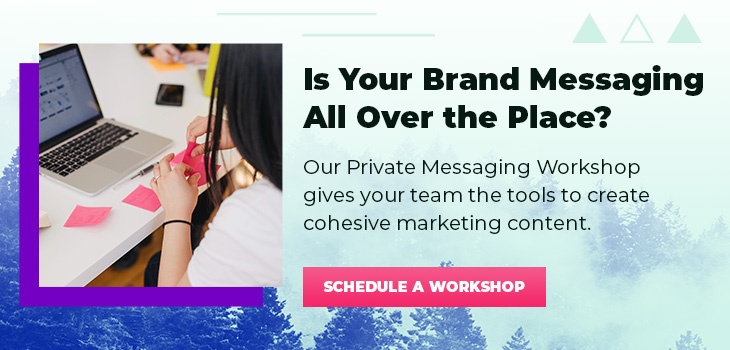[This article has been updated from the original, authored by Tyler Pigott, with new information]
One of my favorite things to do is pull out the old photo albums and go flipping through pages of memories decades old. While reminiscing, there’s one thing people always comment on: the style. Look at that hair! Look at those clothes! Who let me leave the house wearing that? Now, imagine if you still styled yourself the way you did a decade ago. Yeesh!
This scenario is a roundabout way of pointing out that just like your personal wardrobe, your marketing should be updated for the newest developments in the industry. Odds are if you’ve made it to this blog, you know what a buyer persona is. But did you know that marketers aren’t all relying on that standard as heavily as they used to? Many agencies, us included, have moved on to a messaging framework to better frame brands and engage customers.
Buyer personas can go a long way to building up who your potential buyers are, but a messaging framework takes that extra step to determine how to reach them. In this article, we’ll take a look at why buyer personas have been paramount for so long, as well as where they fall short. We’ll also dive into the basics of marketing messages per the StoryBrand Framework because, let’s face it, whether you’re a startup or an established business, it takes more than target audiences and taglines to succeed in today’s marketplace.
The Purpose Behind Buyer Personas
Before we dive into why marketing teams create buyer personas, let’s take a moment to acknowledge exactly what they are: a blueprint of your perfect customer. Personas take a deep dive into the psychology of your target audience. What do they like or dislike? What clothes do they wear? Where do they gather information? It’s the demographic map of the people you’re trying to reach.
You can probably see how this information could be helpful. If you don’t know who you’re speaking to, you might end up trying to sell hamburgers to a vegan. This is the problem buyer personas try to solve; they make sure you’re talking to the right audience. It gives you an idea of your audience's pain points and soft spots so you know exactly where to aim your campaign.
So what’s the problem? Buyer personas only focus on who your audience is and not the words that would resonate with them.
Let’s say you’re still selling hamburgers and your buyer persona has put you in the meat-lovers room. Just because you’re in front of people who would buy your product doesn’t mean you automatically have their business. After all, some of those people might only want organic meat while others opt for grass-fed or extra lean. So how do you tailor your company’s message to demonstrate your niche and engage those customers instead of trying to attract anyone and everyone with generic marketing?
Enter brand messaging.
A Brand Messaging Framework
As I’m sure you guessed, figuring out a buyer persona can take lots of time and intensive research. Although there is a place for that granular research, we decided to focus on how to quickly find an effective message to reach them. This shifted us into using a messaging framework that relies on stories to uncover the right message for the right people.
The structure comes from the StoryBrand Framework, a marketing strategy that helps businesses determine their core messaging and bring sales and success to the next level.
The brand messaging framework is centered around the customer as your hero and your brand as their guide. It turns your service into a story so people readily engage, identify and follow you all the way to the end—purchasing your product. On its base level, the messaging framework has three simple parts:
- Put yourself in the customer’s shoes. Similar to creating a persona to understand your ideal customer, a messaging framework challenges you to identify with your target audience. Namely, what problem are they facing and how can you solve it?
- Create a clear message that addresses the problem. This is where buyer personas fall short. Our messaging framework helps you clearly convey what you want your customers to know.
- Guide them to success. Steps one and two show how your brand will solve a problem and make life better, which helps customers trust your products over similar options. Now you get to be their Mr. Miyagi, their Yoda, their Fairy Godmother. Usher your customers from problem identification to action steps to solutions with a clear message.
When we switched to this approach, the messaging framework ended up carrying the same load as buyer personas, but with a better end result. This is because effective messaging can make your brand more appealing to potential buyers than if you’d stuck with just finding your target audience.
Clearly Define Your Value Proposition
One of the biggest strengths of the StoryBrand Framework is that it naturally draws out your brand promise, which helps you clearly define your value proposition. Creating a clear value proposition is one of the pillars of content marketing. It helps you answer an age-old potential customer question: Why you? Why should they choose your brand over another?
The StoryBrand framework helps you convey the things your customers actually want, instead of the best sound bites of the brand. For example, you might think advertising honesty is the best way to reach your audience, but at the end of the day, honesty isn’t your service and won’t solve their problems. A messaging framework can help you shift your focus onto what customers want out of your brand and then deliver those things on a silver platter.
This idea goes far beyond your mission statement or tagline. The framework shows you how to relate the customer's success back to the external, internal and philosophical problems they're facing. For example, your message could be something like: "We understand how frustrating it can be to wait for hours at a garage while your car is being serviced. You shouldn’t have to waste valuable moments of your day just to maintain your car. That’s why we created On the Go Oil Change to come to you for oil changes and minor repairs."
Now you've boiled down your elevator pitch to four important elements:
- External problem: Sitting in a waiting room for hours while someone works on your car.
- Internal problem: The frustration of waiting for something you thought would be simple.
- Philosophical problem: It simply shouldn't take hours to change your oil.
- Solution: ABC Oil Change guarantees fast, quality service.
By using the messaging template, you've just taken your customer through a step-by-step reasoning of how your business fills a gap in the market. This helps you stand out among the competition, organically introduces your biggest selling points and it will deeply resonate with your target customer. Then these elements can be applied to almost everything in your business, from your content strategy to the way your sales team pitches your services.
More than a Brand Messaging Framework: Clean Up Your Product Messaging
The best thing about the StoryBrand messaging framework is that you can easily apply it to your brand’s core messaging or one marketing campaign. It can be scaled down as far as a single product marketing project. It helps you streamline the marketing messaging process so your products will almost sell themselves.
Buyer personas can give you some great information, but we've found the brand messaging framework is a better way to engage customers by sending the right message to the right people. It allows you to clearly outline your differentiators so customers can easily see how you stand out from the crowd. It also makes it easy to relate your value proposition to prospects so they quickly understand what makes you the best choice. Lastly, the messaging framework is a one-strategy-fits-all approach because it can adapt to a large-scale brand messaging or a single product marketing campaign. It can even be the starting point for a solid positioning statement or the development of your brand voice.
If you want to learn more about the messaging framework and how it could help your business, reach out to us! We love chatting about everything marketing and would be happy to get you on a path to success.









